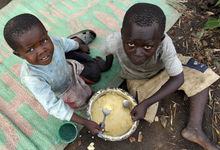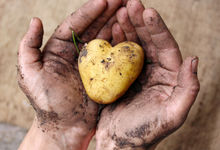Let there be bread
Bread is the staff of life. It belongs both to the poor and the rich. A slice of bread brings out superficial differences: bread saves the hungry from death and is a gratifying comfort food for those who have everything. Some thoughts on World Food Day.

Every year on October 16th, the United Nations celebrates World Food Day, while the International Union of Bakers and Confectioners (UIBC) celebrates World Day of Bread. An unimportant awareness day? Maybe, at least for anyone who always has a basket of bread on his table. But anyone who chews on a piece of bread is also reminded of those who do not have enough to eat—of which there are still far too many on our planet Earth.
A staple and a staff of life
Bread has always been a staple. Bread provides an essential part of our nutrition, like meat or fish or milk. But that does not mean that everyone has access to it. The figures are staggering: every day, 8,500 children die as a result of hunger and malnutrition. In fact, the World Health Organisation estimates that a child dies of hunger every five seconds or so. This is where the petition, “Give us this day our daily bread” (Matthew 6: 11) suddenly takes on a fundamental significance. Billions of times every day it remains unfulfilled. Most people utter these words with a growling stomach. For them, bread is means of survival.
Poverty and hunger: a cycle of horror
The root of all evil? NAK-karitativ writes that agricultural development plays a central role in the battle against hunger and malnutrition. People living in rural regions in the world’s developing countries are considered to be particularly poor. They depend on subsistence farming: on two to seven acres of land they produce just enough to ensure the survival of their own families. Any surplus is sold by the women and girls at the local market or on the side of the road. One storm too many spells disaster. A failed harvest is something no one can afford.
Scientific research has shown that poverty causes malnutrition. For children this has far-reaching consequences. They lack important minerals and vitamins which are important for growth and their general health. Unfortunately, poverty and hunger also have an effect on a person’s education: every day, hundreds of thousands of children go to school hungry. But it is hard to learn on an empty stomach. That means children grow up without mastering the three Rs: reading, writing, and arithmetic. Like their parents, they end up having to feed themselves with subsistence farming, and rear their own children in the same way—a vicious cycle of poverty, in which generation after generation is often trapped.
This is a reason why NAK-karitativ, for example, is focusing on agricultural development in the countries south of the Sahara. The people there need help to start off into a self-determined life. This not only includes food packages but also capacity building initiatives and education projects—all to break the cycle of poverty.
Heedless oblivion
There was a time when manna rained from heaven. Even if it were to rain manna from heaven today, people would likely discard it as organic waste—at least in those countries that have plenty of food. It is hard to believe how much bread and other food is wasted every day and used to produce the necessary heat needed to eliminate real waste. Bread is a gift from God, and sometimes it takes only one slice of bread to be happy.
Hard facts
- 8,500 children die every day as a result of hunger and malnutrition.
- In the countries south of the Sahara, one in four people suffer hunger.
- One in eight people go to bed hungry every night.
- Hunger is the biggest threat to global health. Every year, more people die of starvation than of AIDS, malaria, and tuberculosis together.
- 98 per cent of the world’s undernourished people live in developing countries.
Source: NAK-karitativ
Photo: stefania57 - stock.adobe.com
Article info
Author:
Date:
Keywords:
Peter Johanning
16.10.2018
Social commitment,
Congregational life






